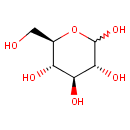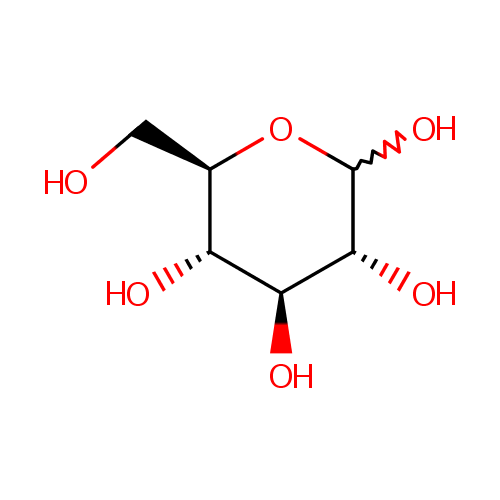
D-Glucose (PAMDB000045)
| Record Information | |||||||||||||||||||||||||||||||||||||||||||||||||||||||||||||
|---|---|---|---|---|---|---|---|---|---|---|---|---|---|---|---|---|---|---|---|---|---|---|---|---|---|---|---|---|---|---|---|---|---|---|---|---|---|---|---|---|---|---|---|---|---|---|---|---|---|---|---|---|---|---|---|---|---|---|---|---|---|
| Version | 1.0 | ||||||||||||||||||||||||||||||||||||||||||||||||||||||||||||
| Update Date | 1/22/2018 11:54:54 AM | ||||||||||||||||||||||||||||||||||||||||||||||||||||||||||||
| Metabolite ID | PAMDB000045 | ||||||||||||||||||||||||||||||||||||||||||||||||||||||||||||
| Identification | |||||||||||||||||||||||||||||||||||||||||||||||||||||||||||||
| Name: | D-Glucose | ||||||||||||||||||||||||||||||||||||||||||||||||||||||||||||
| Description: | Glucose is a monosaccharide containing six carbon atoms and an aldehyde group and is therefore referred to as an aldohexose. The glucose molecule can exist in an open-chain (acyclic) and ring (cyclic) form, the latter being the result of an intramolecular reaction between the aldehyde C atom and the C-5 hydroxyl group to form an intramolecular hemiacetal. In water solution both forms are in equilibrium and at pH 7 the cyclic one is the predominant. Glucose is a primary source of energy for living organisms. It is naturally occurring and is found in fruits and other parts of plants in its free state. | ||||||||||||||||||||||||||||||||||||||||||||||||||||||||||||
| Structure | |||||||||||||||||||||||||||||||||||||||||||||||||||||||||||||
| Synonyms: |
| ||||||||||||||||||||||||||||||||||||||||||||||||||||||||||||
| Chemical Formula: | C6H12O6 | ||||||||||||||||||||||||||||||||||||||||||||||||||||||||||||
| Average Molecular Weight: | 180.1559 | ||||||||||||||||||||||||||||||||||||||||||||||||||||||||||||
| Monoisotopic Molecular Weight: | 180.063388116 | ||||||||||||||||||||||||||||||||||||||||||||||||||||||||||||
| InChI Key: | WQZGKKKJIJFFOK-GASJEMHNSA-N | ||||||||||||||||||||||||||||||||||||||||||||||||||||||||||||
| InChI: | InChI=1S/C6H12O6/c7-1-2-3(8)4(9)5(10)6(11)12-2/h2-11H,1H2/t2-,3-,4+,5-,6?/m1/s1 | ||||||||||||||||||||||||||||||||||||||||||||||||||||||||||||
| CAS number: | 50-99-7 | ||||||||||||||||||||||||||||||||||||||||||||||||||||||||||||
| IUPAC Name: | (3R,4S,5S,6R)-6-(hydroxymethyl)oxane-2,3,4,5-tetrol | ||||||||||||||||||||||||||||||||||||||||||||||||||||||||||||
| Traditional IUPAC Name: | glucose | ||||||||||||||||||||||||||||||||||||||||||||||||||||||||||||
| SMILES: | OC[C@H]1OC(O)[C@H](O)[C@@H](O)[C@@H]1O | ||||||||||||||||||||||||||||||||||||||||||||||||||||||||||||
| Chemical Taxonomy | |||||||||||||||||||||||||||||||||||||||||||||||||||||||||||||
| Taxonomy Description | This compound belongs to the class of organic compounds known as monosaccharides. These are compounds containing one carbohydrate unit not glycosidically linked to another such unit, and no set of two or more glycosidically linked carbohydrate units. Monosaccharides have the general formula CnH2nOn. | ||||||||||||||||||||||||||||||||||||||||||||||||||||||||||||
| Kingdom | Organic compounds | ||||||||||||||||||||||||||||||||||||||||||||||||||||||||||||
| Super Class | Organooxygen compounds | ||||||||||||||||||||||||||||||||||||||||||||||||||||||||||||
| Class | Carbohydrates and carbohydrate conjugates | ||||||||||||||||||||||||||||||||||||||||||||||||||||||||||||
| Sub Class | Monosaccharides | ||||||||||||||||||||||||||||||||||||||||||||||||||||||||||||
| Direct Parent | Monosaccharides | ||||||||||||||||||||||||||||||||||||||||||||||||||||||||||||
| Alternative Parents | |||||||||||||||||||||||||||||||||||||||||||||||||||||||||||||
| Substituents |
| ||||||||||||||||||||||||||||||||||||||||||||||||||||||||||||
| Molecular Framework | Aliphatic heteromonocyclic compounds | ||||||||||||||||||||||||||||||||||||||||||||||||||||||||||||
| External Descriptors |
| ||||||||||||||||||||||||||||||||||||||||||||||||||||||||||||
| Physical Properties | |||||||||||||||||||||||||||||||||||||||||||||||||||||||||||||
| State: | Solid | ||||||||||||||||||||||||||||||||||||||||||||||||||||||||||||
| Charge: | 0 | ||||||||||||||||||||||||||||||||||||||||||||||||||||||||||||
| Melting point: | 146-150 °C | ||||||||||||||||||||||||||||||||||||||||||||||||||||||||||||
| Experimental Properties: |
| ||||||||||||||||||||||||||||||||||||||||||||||||||||||||||||
| Predicted Properties |
| ||||||||||||||||||||||||||||||||||||||||||||||||||||||||||||
| Biological Properties | |||||||||||||||||||||||||||||||||||||||||||||||||||||||||||||
| Cellular Locations: | Cytoplasm | ||||||||||||||||||||||||||||||||||||||||||||||||||||||||||||
| Reactions: | Phosphoenolpyruvic acid + D-Glucose > Glucose 6-phosphate + Pyruvic acid Ubiquinone-8 + D-Glucose + Water > Ubiquinol-8 + Gluconic acid + Hydrogen ion Adenosine triphosphate + Water + D-Glucose > ADP + D-Glucose + Hydrogen ion + Phosphate Adenosine triphosphate + Water + D-Glucose > ADP + D-Glucose + Hydrogen ion + Phosphate Water + alpha-Lactose > D-Galactose + D-Glucose Water + Maltotetraose > D-Glucose + Maltotriose Water + Maltoheptaose > D-Glucose + Maltohexaose Water + Maltohexaose > D-Glucose + Maltopentaose Water + Maltopentaose > D-Glucose + Maltotetraose Acetyl-CoA + D-Glucose <> 6-Acetyl-D-glucose + Coenzyme A Glucose 6-phosphate + Water > D-Glucose + Phosphate Glucose 1-phosphate + Water > D-Glucose + Phosphate Adenosine triphosphate + D-Glucose > ADP + Glucose 6-phosphate + Hydrogen ion D-Maltose + Maltotriose > D-Glucose + Maltotetraose D-Maltose + Maltotetraose > D-Glucose + Maltopentaose D-Maltose + Maltohexaose > D-Glucose + Maltoheptaose D-Maltose + Maltopentaose > D-Glucose + Maltohexaose D-Glucose <> D-Fructose Water + Melibiose > D-Galactose + D-Glucose Water + Trehalose 6-phosphate > Glucose 6-phosphate + D-Glucose Trehalose + Water <>2 D-Glucose Sucrose + Water <> D-Fructose + D-Glucose More...Protein N(pi)-phospho-L-histidine + D-Glucose <> Protein histidine + Glucose 6-phosphate Cyanoglycoside + Water <> Cyanohydrin + D-Glucose cis-beta-D-Glucosyl-2-hydroxycinnamate + Water <> cis-2-Hydroxycinnamate + D-Glucose 1,4-alpha-D-glucan + D-Glucose <> D-Maltose Neohancoside D + Water <> D-Fructose + D-Glucose Melibiose + Water <> D-Galactose + D-Glucose Lactose + Water <> D-Glucose + D-Galactose D-Glucose + Ubiquinone-1 <> Gluconolactone + Ubiquinol-8 D-Glucose <> b-D-Glucose a 1,4-α-D-glucan + Water > a 1,4-α-D-glucan + D-Glucose Maltotriose + Water > D-Maltose + D-Glucose nigerose + Water D-Glucose Trehalose + Water > b-D-Glucose + D-Glucose 6-Phospho-beta-D-glucosyl-(1,4)-D-glucose + Water > D-Glucose + Glucose 6-phosphate D-Glucose + Ubiquinone-10 > Gluconolactone + Ubiquinol-1 Adenosine triphosphate + D-Glucose > ADP + Glucose 6-phosphate Cellobiose-6-phosphate + Water <> D-Glucose + Glucose 6-phosphate D-Glucose + Adenosine triphosphate > Hydrogen ion + Adenosine diphosphate + beta-D-Glucose 6-phosphate + ADP Sucrose + Water <> D-Fructose + D-Glucose + D-Fructose D-Glucose + [PTS enzyme I]-N?-phospho-L-histidine > β-D-glucose 1-phosphate + [PTS enzyme I]-L-histidine | ||||||||||||||||||||||||||||||||||||||||||||||||||||||||||||
| Pathways: |
| ||||||||||||||||||||||||||||||||||||||||||||||||||||||||||||
| Spectra | |||||||||||||||||||||||||||||||||||||||||||||||||||||||||||||
| Spectra: | |||||||||||||||||||||||||||||||||||||||||||||||||||||||||||||
| References | |||||||||||||||||||||||||||||||||||||||||||||||||||||||||||||
| References: |
| ||||||||||||||||||||||||||||||||||||||||||||||||||||||||||||
| Synthesis Reference: | Li, Dalin; Ruan, Yi; Song, Wen; Wang, Yongjun. Improved process for producing glucose. Faming Zhuanli Shenqing Gongkai Shuomingshu (2003), 4 pp | ||||||||||||||||||||||||||||||||||||||||||||||||||||||||||||
| Material Safety Data Sheet (MSDS) | Not Available | ||||||||||||||||||||||||||||||||||||||||||||||||||||||||||||
| Links | |||||||||||||||||||||||||||||||||||||||||||||||||||||||||||||
| External Links: |
| ||||||||||||||||||||||||||||||||||||||||||||||||||||||||||||
Enzymes
- General function:
- Involved in glucokinase activity
- Specific function:
- Not highly important in Pseudomonas aeruginosa as glucose is transported into the cell by the PTS system already as glucose 6-phosphate
- Gene Name:
- glk
- Locus Tag:
- PA3193
- Molecular weight:
- 34.6 kDa
Reactions
| ATP + D-glucose = ADP + D-glucose 6-phosphate. |
- General function:
- Involved in catalytic activity
- Specific function:
- Provides the cells with the ability to utilize trehalose at high osmolarity by splitting it into glucose molecules that can subsequently be taken up by the phosphotransferase-mediated uptake system
- Gene Name:
- treA
- Locus Tag:
- PA2416
- Molecular weight:
- 61.2 kDa
Reactions
| Alpha,alpha-trehalose + H(2)O = 2 D-glucose. |
- General function:
- Involved in oxidoreductase activity, acting on CH-OH group of donors
- Specific function:
- GDH is probably involved in energy conservation rather than in sugar metabolism
- Gene Name:
- gcd
- Locus Tag:
- PA2290
- Molecular weight:
- 86.2 kDa
Reactions
| D-glucose + ubiquinone = D-glucono-1,5-lactone + ubiquinol. |
- General function:
- Involved in hydrolase activity, hydrolyzing O-glycosyl compounds
- Specific function:
- Hydrolysis of terminal, non-reducing beta-D- glucosyl residues with release of beta-D-glucose
- Gene Name:
- bglX
- Locus Tag:
- PA1726
- Molecular weight:
- 83 kDa
Reactions
| Hydrolysis of terminal, non-reducing beta-D-glucosyl residues with release of beta-D-glucose. |
- General function:
- Involved in oxidoreductase activity, acting on the CH-OH group of donors, quinone or similar compound as acceptor
- Specific function:
- Aldose sugar dehydrogenase with broad substrate specificity. The physiological substrate is unknown. Can oxidize glucose to gluconolactone. Can also utilize D-arabinose, L- arabinose and 2-deoxy-glucose. Has higher activity towards oligomeric sugars, such as maltose, maltotriose or cellobiose. It may function to input sugar-derived electrons into the respiratory network
- Gene Name:
- yliI
- Locus Tag:
- PA1112
- Molecular weight:
- 41.4 kDa

